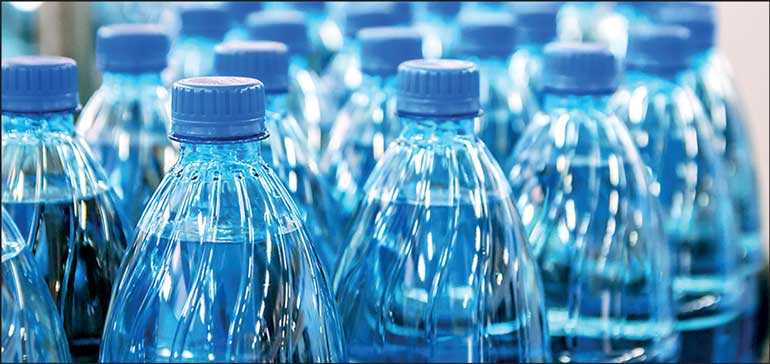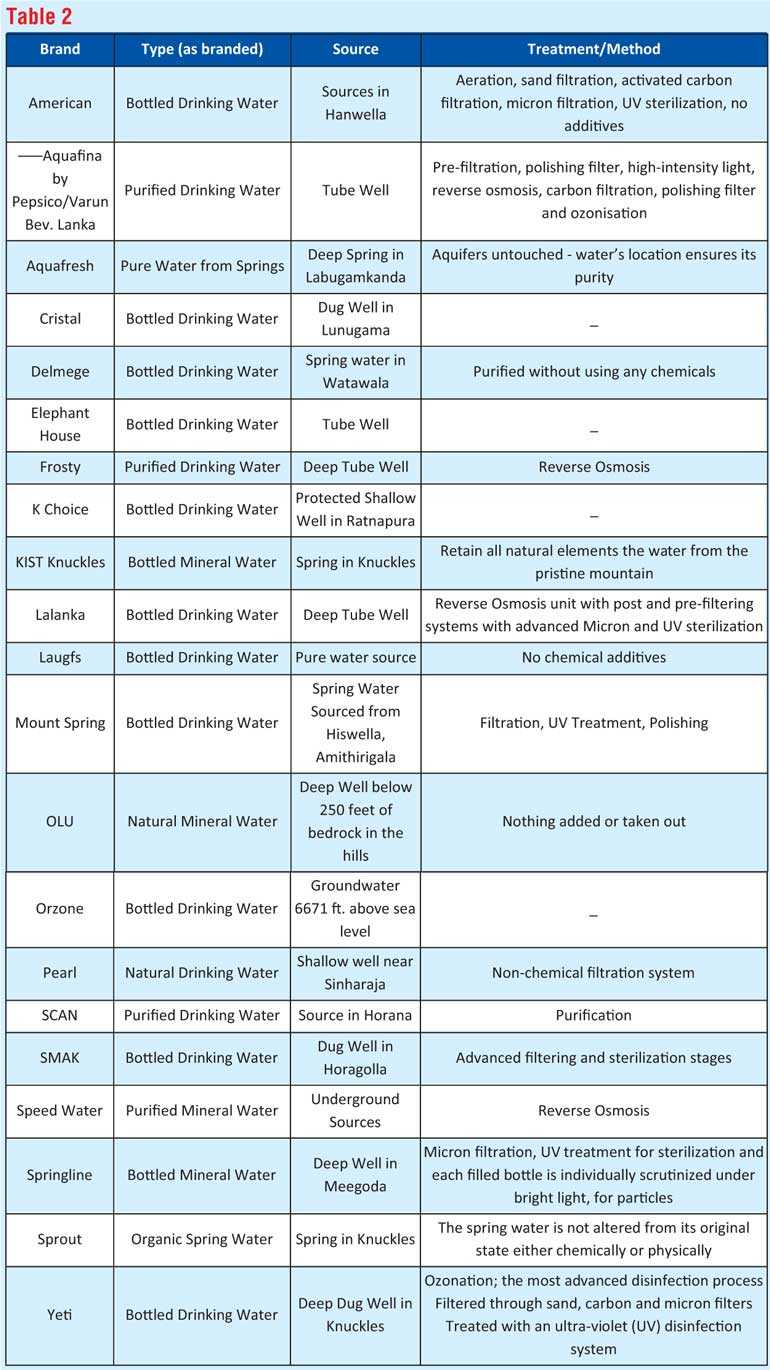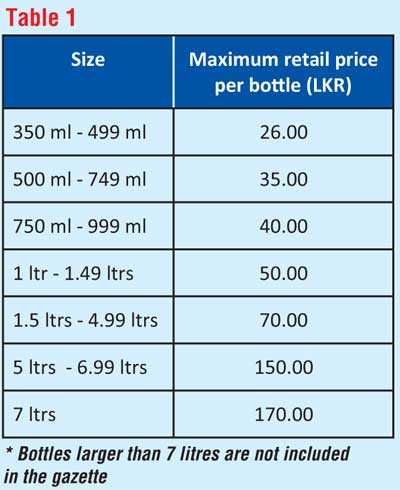Monday Dec 22, 2025
Monday Dec 22, 2025
Wednesday, 5 December 2018 00:00 - - {{hitsCtrl.values.hits}}


The recently instilled price control on bottled water seems like a positive for all consumers. How can a lower priced good hurt society? A recent report by the Advocata Institute ‘Price Controls in Sri Lanka1’ finds that price controls are of limited value in reducing costs. 
The report claims that price controls can cause significant welfare losses, deterioration in product quality, reduction in investment and, in the long run, higher prices. Hence, one must approach production and economic fundamentals to observe price controls’ potentially detrimental outcomes.
As per the extraordinary gazette notification2 released by the Government on 5 October, the maximum retail prices of bottled water is seen in table 1.
As shown (table), the new ceiling prices shave off a fair chunk of the bottled water seller’s margin (for instance, the cheapest common 500ml brand retailed at Rs. 45). This falling margin trickles down from the retailer/wholesaler to the distributor and eventually the producer (bottler). As with any economic activity, the goal is to generate profit. This aim remains with the producer to the retailer, and a ceiling price disrupts economic activity. We must observe how this industry operates.
The common water bottler sources his PET (polyethylene terephthalate) bottles from local plastic producers or importers. These bottles are a product of the petrochemical industry, a sector of rising cost due to increasing petroleum prices, internationally. Additionally, the ailing Sri Lankan Rupee has done no favours to importers.
The water is sourced from dug wells to springs and deep wells, and various brands treat the water using different techniques (like pricey reverse osmosis or cheaper chemical treatment). The water and the PET bottles need to abide by a predetermined SLS criteria and Health Ministry specifications. Additionally, they undergo licensing (with periodic renewals), site inspections, water and product testing and random checks (by the Consumer Affairs Authority).
The finished water bottles then make their way to wholesalers or retailers, to be purchased in large quantities (for events or corporates) or shelved at boutiques and supermarkets. This is done with the help of distributors, who range from large corporate in-house logistics departments, to the DIMO Batta owners outstation. This price control lowers the distributor’s margin, potentially removing the smaller distributors altogether. The larger sellers, like Keells with ‘K Choice’ water or Cargills’ ‘KIST Knuckles’, vertically integrate the entire process. It will no longer be in the interest of these supermarket oligopolies, to use up shelf space for rival brands (this is already apparent in some Keells outlets) and eventually the consumer suffers with few to no brand alternative. The price ceiling acts as a barrier to entry for new producers, as now they do not have the freedom to charge prices in line with economic forces. Existing producers may be forced out of the market or absorbed by larger entities. In economic terms, consumer choice falls.
A shift to aggressively cut costs could lead to lower quality plastic, (albeit still in line with health standards) being used and recycled. Furthermore, cheaper alternatives to water purification like chemical treatment will become the standard, despite poorer taste and lower healthy mineral content. A fall in research and development investment will lower innovation into current and future water products and services and this too will be at cost to the consumer.
Lower priced bottled water leads to higher demand and consumption. This does not bode well for the environment, owing to more plastic use and waste. Sri Lanka annually imports 9,600 tonnes3 of raw virgin plastic (PET) to manufacture bottles, packaging and for other requirements. 70% of this is processed and consumed as an end product in Sri Lanka and the used plastic waste creates monstrous environmental issues. Although recyclers are trying to address this issue, the price control in question could severely contribute to even greater plastic waste.
Tap water is the cheapest water option available. It usually goes through a process of basic filtration techniques like flocculation, which adds chemicals to the water to get particles to coagulate and float, so that they can be removed; sand filtration, which filters out large pieces of debris; or chlorination, which adds chlorine to kill bacteria and microorganisms. Despite tap water being considered drinkable (to some, purely out of convenience), it can lead to numerous problems. Chlorine is not ideal for human consumption (while our bodies can technically handle it, chlorine can lead to a variety of health complications and is potentially carcinogenic). The presence of microbes and impurities from pipes add health issues too. These risks have not gone unnoticed as we observe tourist forums and foreign travel bloggers strongly urging future visitors to avoid Sri Lankan tap water and to always opt for sealed bottled water. This leads on to the variety of bottled water available to consumers.
Artesian Water: Water from a well that taps a confined aquifer (a water-bearing underground layer of rock or sand) in which the water level stands at some height above the top of the aquifer.
Spring Water: Water derived from an underground formation from which water flows naturally to the surface of the earth.
Purified Water: Water that has been produced by distillation, deionization, reverse osmosis, or other suitable processes.
Distilled Water: Water that has been vaporized into steam, then cooled to re-condense it back into water. The water’s minerals are left behind, leaving only pure tasting steam-distilled water. Mineral Water: Water that contains no less than 250 parts per million (ppm) total dissolved solids (TDS). It is evident that a variety of water sources can be tapped and different purification methods can be employed to produce consumable water. This “clean, drinkable water” is then bottled and intensely marketed across a spectrum of brands, along with their source and unique purification methodology. Seen in table 2 is a collection of some local branded water. (Source: bottle label/bottler website)
These bottles contain drinking water that was sourced differently. It was then processed (filtered/purified) differently. The plastic it is contained in is not standardised (it just has to fulfil a minimum health and quality requirement). These aspects of a seemingly simple good exposes variety with differentiability, and this may sway demand for one brand over the other. This should influence price and create a variation of prices for different brands, at the stimulus of consumer choice.
However, in essence, this price control has homogenised a differentiable good. The consumer now pays one price across a range of bottled water.
The price ceiling, although seemingly to help us buy cheaper bottled water, could cycle back to hinder the bottled water industry from giving the end consumer the best possible product. Water is not a scarce good (yet) in Sri Lanka and there are plenty of existing alternatives to bottled water. Has the government truly taken this into consideration? How have the new prices been calculated? What research has been carried out? Has a cost benefit analysis been performed? If so, where is it? Where is the data? Despite multiple attempts to communicate with senior employees at the CAA4, we failed to gather any meaningful answers, useful information nor a compliant contact. Why does the CAA pass the buck to its ministry who in turn has no one willing to answer these queries? Does society truly benefit from this seemingly positive, yet irrational gazette? Who really stands to benefit from this decision in the long run?
(The writer is part of the research team at the Advocata Institute. He holds a BSc. Mathematics and Economics from the University of London. Advocata is an independent policy think tank based in Colombo, Sri Lanka. They conduct research, provide commentary and hold events to promote sound policy ideas compatible with a free society in Sri Lanka. Visit www.advocata.org for more information.)
Footnotes
1https://www.research.advocata.org/pricecontrol
2http://www.documents.gov.lk/files/egz/2018/9/2090-46_E.pdf
3http://www.dailynews.lk/2017/05/02/business/114626/recycling-plastic-waste-bppl-way
4http://www.caa.gov.lk/web/index.php?option=com_content&view=article&id=141&Itemid=591&lang=en